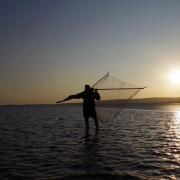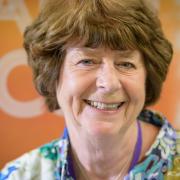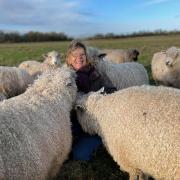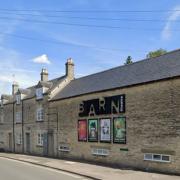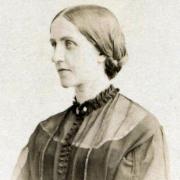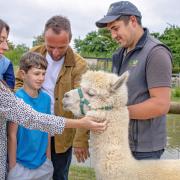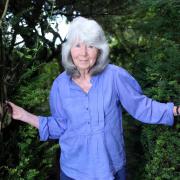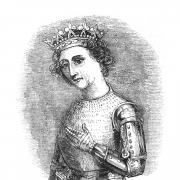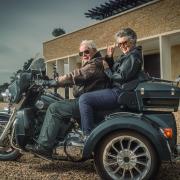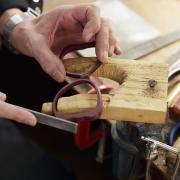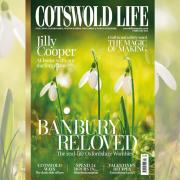Sabrina Pace-Humphreys grew up in Stroud, Gloucestershire – a privileged part of the country. Or not, depending on perspective. For Sabrina – a Black child in a white community – the rural Cotswolds meant a daily ordeal of bullying, physical threats and brutal isolation. Katie Jarvis spoke to her about her new book, Black Sheep
I am different to all the girls in my school. My hair is different, my skin is different, my nose is different. And my difference isn’t a good thing. I am a blackie. That’s one of the words they call me. I am fuzzy.
From Black Sheep: A Story of Rural Racism, Identity and Hope
The Alps, July 2019, a chilly summer morning. The scenery is stunning, and Sabrina Pace-Humphreys is about to die.
She’s clinging to the edge of a precipice, her lower body dangling over the kind of drop that tourists buy on dramatic postcards to show off to those at home. Sabrina’s fingers desperately dig into the only purchase she can find – soft, wet snow; snow that breaks apart to the touch. Her scrabbling feet are faring no better. Beautiful, treacherous snow.
The previous second, she’d been carefully negotiating a narrow ledge, using her poles to balance; the next, her right foot has skidded from under her.
And here she hangs, the ground unreachably just above; or all-too-reachably far, far below.
She’s 41. Too young to die. Terrified. Sobbing.
But it’s OK. It will be fine. She’s taking part in a mountain ultra-marathon. An official event where other competitors will pass by any second.
It really will be fine.
Sure enough, a man appears on the path. Then a second. A third, a fourth, a fifth.
Strong men, whose bodies are at peak of fitness; who’ve trained to withstand the physical pressures of running 8,000 feet above sea-level, under a clear blue sky in the Haute-Savoie.
Men who understand the moral code of these events. If a person is down, you stop; you put your race to one side.
(Of course you do! That’s the moral code of life.)
And yet.
One by one, each of those men blanks her as she screams mere metres away. One alone throws out a casual response to her desperate cries. (‘Help me! I can’t hold on!’)
‘Poles,’ he says, not breaking his stride.
(What does he even mean?)
Then. A sixth appears. He stops – stops! – grabs her forearm with life-saving grip. He shows her what to do – they don’t speak the same language – slowly, slowly, hauling her onto the path.
Five white men have passed by.
One brown-skinned Italian has saved her.
Sabrina is Black.


SABRINA PACE-HUMPHREYS opens her door with the warmest of smiles. ‘I’m so glad it’s you writing the piece!’ she says.
I mean, me, too. We know each other! For years, Sabrina ran an award-winning PR company I would deal with. A company with an outstanding reputation.
Yes, we know each other.
Neil, her husband, tucked away in his home-office, raises a hand in cheery wave. The house is a project-in-the-making; building work in progress. (The kitchen is already part-fabulous.) In the garden is another office, from where Sabrina now runs a personal training business.
Down the road is the Stroud grammar school I attended.
All so familiar.
Yes, we know each other… Don’t we?
The thing is this. After I’ve read Sabrina’s book – Black Sheep; A Story of Rural Racism, Identity and Hope – I scour all my old, archived emails to and from each other; emails I haven’t thought much about after pressing ‘send’. I scour them for clues; to see if I missed anything.
Because the book shocks me to the core. It’s a story of Stroud from the 1980s to the present day. My Stroud. Her Stroud. Two different worlds in the same location.
In mine, I thrived; fitted in; sailed through education to a top university.
In Sabrina’s, every bus journey to school is a war. ‘Oi, wog. Nigger. Oi, nignog… Answer me when I speak to you, girl. Your master is addressing you, Nigga.’
(It’s shocking language to use in a magazine. I know that. But how can I filter the truth?)
While I challenged myself with hours of Virgil, Ovid, Tacitus, Sabrina challenged herself with sad songs, sad movies; forced herself to imagine loved ones dying in accidents.
I studied Latin like Sabrina studied the art of not crying in front of her tormentors.


MY GOD, I SAY to Sabrina, as we sit down to talk. What courage must it have taken to expose yourself like this…
Because traumas from childhood never go away. As she sat and wrote her book, she must have been that racially abused little girl all over again.
‘Oh, I had to be,’ she says, ‘in order to do the story justice – although I didn’t realise how mentally exhausting and trauma-reliving that would be. But I thought to myself: If this book is the only one I write, it has to be for people who want to understand what it is to be a person of colour living in these rural spaces.
‘Because it’s so isolating. You look around and there’s no one who looks like you. You don’t see community groups or your culture reflected in anything around you – food, music.
‘Yet from that young age, all I wanted was a connection. Throughout all those trauma years – being a child, teenager, young adult – I was constantly searching for something to connect with someone about so I could ask: Do they call you this, too? Do they do this to you, too? How do you cope with that?’
She’s not exaggerating her isolation one iota.
Her parents – her white mum and her Black father – split when Sabrina was three; on her light-skinned sister’s first birthday. Her mum, originally from Scotland, (‘You’re nae buckin’ daughter o’ mine. Never set foot on Scottish soil again’), ended up in Stroud, raising two daughters on her own. In poverty. Fighting her own mental health issues.
So perhaps it’s not surprising that Sabrina was destined to continue the cycle. To become – as she did - a teenage unmarried mother of two, barely literate. Followed by a slow slide into alcoholism, many years after that first delightfully pain-numbing stolen sip of Martini at Minch Youth Club, aged 14.
READ MORE: Why Jools Holland is delighted to be called a 'throwback'.

I’VE ALREADY REVEALED – of course – that this is ultimately a success story. But it’s a roller-coaster, too. There’s no room, here, to detail the nuances; the highs and lows; the shocking stories unfiltered in Black Sheep. Suffice to say, if you only read one book this year, make it this one. Especially if you live in the Cotswolds.
So, (and I understand this is a ridiculously simplistic question in a book of this import) what saved her?
What saved Sabrina?
…Who can answer that question, really. But, for sure, three things helped.
The love and unfaltering support of Neil, father of her two younger children; and loving stepfather of her older two.
A hairdresser called Fiona, in Barton Street, Gloucester – a multicultural street considered (therefore) ‘unsafe’; Do Not Travel Alone territory. (If you’re amazed that a hairdresser can help rescue a life, then here’s a learning curve that I first followed when reading Chimamanda Ngozi Adichie’s Americanah.) Fiona, a Black woman, was the first person in Sabrina’s life who understood how to cut her Afro-Caribbean hair. Hair that was the visual reminder of how different Sabrina was even from her own immediate family.
And then there’s running.
If you look on Sabrina’s social media today, you’ll see photos of her in running gear; holding race numbers; sporting medals. She’s even graced the cover of national Women’s Running Magazine.
‘You don’t see a lot of Black, mixed race, 44-year-old mothers of four, grandmothers of three, on the covers of running magazines,’ she jokes. But she’s proud – and rightly so – of how that cover represents the physical and metaphorical mountains she’s climbed.
Running – the story of the latter half of her book – helped begin her fight-back from alcoholism. Running has taken her over the world, including on the 250-kilometre foot race that takes place each year in the Sahara.


We know that running releases endorphins – feel-good chemicals – that improve mood, as well as fitness. And that has certainly been a part of it.
But it’s also about reclaiming spaces. About the fact that, so often when Sabrina is out on her runs, on her races, there won’t be another Black person in sight.
So let’s return to that initial real-life scene. To that day in 2019 when Sabrina was clinging to life on a mountain trail in the Alps. It’s such a stark metaphor for all she has been through.
But does she really think – really and truly – that those five white men ran carelessly past because she’s Black?
She hasn’t a scintilla of doubt. ‘If I had been blond-haired, blue-eyed and white, I would have been offered a hand off that ledge a lot quicker. My lived experience tells me that. I would not have had to endure that trauma for as long.’


SABRINA HAS CHANGED for sure. But has Stroud? Have we? Friends, strangers, even people in authority – particularly so, in fact – continue to make inappropriate comments at best; to fail to acknowledge her lived experience.
Stroud’s Blackboy Clock in Castle Street – a 240-year-old caricature of a Black child – is a prime example. Though the council is exploring whether or not to remove it, the controversy has been explosive. ‘When I was a child, I was called the ‘n’ word; I was told that I should listen to what my master tells me. Can you imagine what it’s like for a person of colour, walking around their local town, looking up and seeing represented on a wall a Black child you were told you looked like? Tethered by a ring around its neck.
‘So, why not just move it? It’s been moved five times. Put it into Stroud Museum so people can actually learn from it.
‘Yet in any of the stuff I’ve read – and I haven’t read a lot because it can be quite mentally draining – not one person has said, ‘But what do people of colour in the town feel?’’
That’s a high-profile issue. Just as incredible – if you think about it – is the fact that neither of her schools taught pupils about – or even mentioned – Stroud’s prominent anti-slavery monument, the Archway.
‘I don’t remember being taught anything about local Black history. In fact, I don’t even remember a teacher pulling me aside and just asking if I was OK, even though I was obviously struggling.’
That was more than 30 years ago. Is life any better for children of colour growing up in Stroud today?

‘I believe the issues remain… No, I don’t believe it. I know it. The ‘bus ride’ still happens daily. No care-taker on the bus; no one wanting to take responsibility for it. If anything, it’s worse. I was never threatened with a knife when I was on the bus. Yes, they threatened to burn my hair with matches; shove me. But no knives.’
So, what does Sabrina Pace-Humphreys think about human nature? This woman, who has welcomed me so warmly into her home? Who – for all her justified anger – interweaves all she says with positives; who glows with success and, yes, happiness. Who has found her true self in rural Stroud.
‘I have to believe whole-heartedly that, ultimately, people are good – and I do believe it. Yes, in my lived experience, I have seen the other side. But I have hope.’
Hope that this book will make even one person say, I had no idea. But, now I do, I’m going to make a small change.
Hope that those others who say, ‘I don’t see your colour; I see you’, will gain insight.
Because one of the things Sabrina wants Stroud to see is her colour.
‘Finally, after 44 years, I am a proud, Black, mixed race woman; so it’s important that you see me as that. And you calling me Black doesn’t make me feel ashamed. It makes me take up my power.’

Black Sheep by Sabrina Pace-Humphreys is published in hardback by Quercus, £16.99. Sabrina will be appearing at Stroud Book Festival in November: stroudbookfestival.org.uk
Sabrina is co-founder of Black Trail Runners, a volunteer-run charity aiming to break down the barriers to access that mean Black people miss out on outdoor spaces such as National Park and National Trails: blacktrailrunners.run




